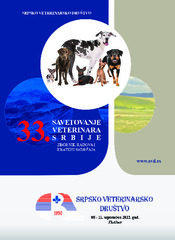Приказ основних података о документу
Modulacijom metabolizma krava do ekološki prihvatljive proizvodnje na govedarskim farmama
| dc.creator | Kirovski, Danijela | |
| dc.creator | Nedić, Sreten | |
| dc.creator | Jovanović, Ljubomir | |
| dc.creator | Prodanović, Radiša | |
| dc.creator | Stojković, Milica | |
| dc.creator | Bošnjaković, Dušan | |
| dc.creator | Vujanac, Ivan | |
| dc.date.accessioned | 2023-06-06T11:25:32Z | |
| dc.date.available | 2023-06-06T11:25:32Z | |
| dc.date.issued | 2022 | |
| dc.identifier.isbn | 978-86-83115-47-1 | |
| dc.identifier.uri | https://vet-erinar.vet.bg.ac.rs/handle/123456789/2939 | |
| dc.description.abstract | Poljoprivredni sektor predstavlja najznačajniji pojedinačni antropogeni izvor metana sa farmama visokomlečnih krava koje daju najveći doprinos u emisiji metana. Metan je drugi po značaju gas sa efektom staklene bašte, odmah posle ugljen-dioksida, koji se fiziološki stvara u buragu preživara. Naime, burag predstavlja sredinu koju nastanjuje zajednica mikroorganizama (mikrobiom), koja uključuje različite vrste anaerobnih bakterija, arheja, protozoa, gljivica i faga. Glavna uloga ovih mikroorganizama je razlaganje sastojaka biljne hrane koji ne mogu biti razloženi enzimskim sistemom domaćina, što rezultira oslobađanjem krajnjih proizvoda fermentacije – isparljivih masnih kiselina. Ovi proizvodi fermentacije se, nakon resorpcije iz digestivnog trakta, koriste za sintezu kompleksnih jedinjenja u različitim tkivima (mišićima, mlečnoj žlezdi i drugim), uključujući proteine, masti i druga jedinjenja, koji proizvode animalnog porekla čine nutritivno vrednim za ljude. Međutim, procesi fermentacije u buragu su praćeni i oslobađanjem ugljen-dioksida i vodonika, koje metanogene arheje koriste za sintezu metana. NJegovo prekomerno oslobađanje u spoljašnju sredinu doprinosi efektu staklene bašte i globalnom zagrevanju. Dodatno, sinteza metana u buragu predstavlja metabolički put kojim se gubi 2 – 12 procenata energije hrane. Zbog toga se interes za smanjenje njegove emisije ne nalazi samo u zaštiti životne sredine, već i u potencijalnom povećanju produktivnosti životinja, koja nosi ekonomsku korist za farmere koji su jedna od ključnih karika u planiranju mera za smanjenje emisije metana sa govedarskih farmi. Različiti nutritivni dodaci mogu modulirati metaboličke procese i time doprineti smanjenju emisije metana od strane mlečnih krava. U tom pogledu, najviše se izučavaju tanini i drugi biljni ekstrakti, kao što su uljani ekstrakt belog luka i ekstrakti različitih morskih algi, uključujući crvene i braon morske alge. | sr |
| dc.description.abstract | The agricultural sector represents the single most significant anthropogenic source of methane, with dairy farms the dominant contributor to methane emissions. Methane is the second most important greenhouse gas, after carbon dioxide, which is physiologically produced in the rumen of ruminants. Namely, the rumen represents an environment inhabited by a community of microorganisms (microbiome), which includes various species of anaerobic bacteria, archaea, protozoa, fungi, and phages. The primary role of these microorganisms is to break down plant components that cannot be broken down by the host’s enzymatic system, which results in the release of the end products of fermentation - volatile fatty acids. After resorption from the digestive tract, these fermentation products are used to synthesize complex compounds in various tissues (muscles, mammary gland, etc.), including proteins, fats and others, which make animal products nutritionally valuable for humans. However, fermentation processes in the rumen are accompanied by the release of carbon dioxide and hydrogen, which methanogenic archaea use for the synthesis of methane, whose excessive release into the environment contributes to the greenhouse effect and global warming. Additionally, the synthesis of methane in the rumen is a metabolic pathway through which 2-12% of food energy is lost. Therefore, the interest in reducing methane emissions is not only in environmental protection but also in the potential increase in animal productivity, which brings economic benefits to farmers, which are one of the crucial links in planning measures to reduce methane emissions from cattle farms. Different nutritional supplements can modulate metabolic processes and thus contribute to reducing methane emissions by dairy cows. In this regard, tannins and other plant extracts, such as garlic oil extract, but also extracts from various seaweeds, including red and brown seaweeds, are recognized as the most important supplements in reducing methane emissions. | sr |
| dc.language.iso | sr | sr |
| dc.publisher | Beograd : Srpsko veterinarsko društvo | sr |
| dc.relation | info:eu-repo/grantAgreement/ScienceFundRS/Ideje/7750295/RS// | sr |
| dc.rights | openAccess | sr |
| dc.rights.uri | https://creativecommons.org/licenses/by/4.0/ | |
| dc.source | 33. Savetovanje Veterinara Srbije, Zlatibor, 08 - 11. septembar 2022 | sr |
| dc.subject | enterična fermentacija | sr |
| dc.subject | metan | sr |
| dc.subject | metanogene arheje | sr |
| dc.subject | modulacija metabolizma | sr |
| dc.subject | nutritivni dodaci | sr |
| dc.subject | enteric fermentation | sr |
| dc.subject | methane | sr |
| dc.subject | methanogenic archaea | sr |
| dc.subject | modulation of metabolism | sr |
| dc.subject | nutritional supplements | sr |
| dc.title | Modulacijom metabolizma krava do ekološki prihvatljive proizvodnje na govedarskim farmama | sr |
| dc.type | conferenceObject | sr |
| dc.rights.license | BY | sr |
| dc.citation.spage | 219 | |
| dc.citation.epage | 229 | |
| dc.description.other | Zbornik radova i kratkih sadržaja | sr |
| dc.identifier.fulltext | http://veterinar.vet.bg.ac.rs/bitstream/id/8654/bitstream_8654.pdf | |
| dc.identifier.rcub | https://hdl.handle.net/21.15107/rcub_veterinar_2939 | |
| dc.type.version | publishedVersion | sr |

